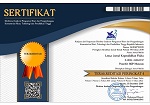DEVELOPMENT OF LEARNING MEDIA USING ADOBE AFTER EFFECT IN DYNAMIC ELECTRICITY SUBJECT MATTER
DOI:
https://doi.org/10.33394/j-lkf.v4i1.35Keywords:
Learning Media dan Software adobe after effectAbstract
This research is the development of instructional videos. The purpose of this study was to develop ICT based learning media that can enhance students' understanding on the dynamic electrical material. This study uses 4D model of development which define, design, develop and disseminate. This study only uses three phases to the development stage video designed using Software adobe after effect. Further testing in two stages, the process of validation and surveys. The validation process performed by the second validator of the quality and appropriateness of instructional media content with an average score of 3.25 thus classified as "Highly Valid". Furthermore, the survey of 14 students of 4th semester of physics education by looking at appeal and the general look of the media with the acquisition of an average score of 3.13 and included the category "Agree". Thus deserve to be a program developed as a learning medium and can be used in science teaching junior class IX on the subject of dynamic electricity.
References
Arda,dkk. 2012. Pengembangan Media Pembelajaran Interaktif Berbasis Komputer untuk Siswa SMP.UniversitasTadulako
Bahri Syaiful, dkk. 2010. Strategi Belajar Mengajar. Jakarta: Rineka Cipta
Bahtiar dan Prayogi, 2012. Evaluasi Hasil Pembelajaran Sains (IPA). Mataram: CV. Dimensi Raya
Hendratman, Hendi. 2005. The magic of adobe after effect. Bandung: Informatika
Mulyatiningsih Endang. 2014. Metode Penelitian Terapan Bidang Pendidikan. Bandung: CV Alfabeta
Sakti, Indra. 2012. Pengaruh Media Animasi Fisika Dalam Model Pembelajaran Langsung (direct instruction) Terhadap Minat Belajardan Pemahaman Konsep Fisika Siswa. Bengkulu: Unila
Usman, dkk. 2013. Pemanfaatan Media Animasi Komputer dalam Pembelajaran IPS Untuk Perolehan Belajar Konsep Perdagangan Internasional di Kelas IX MTs.Negeri 1 Pontianak. Pontianak : FKIP UniversitasTanjungpura
Slameto. 2007. Model Pembelajaran Terpadu dalam Teori dan Praktek. Jakarta. Prestasi Pustaka
Sudrajat. 2008. Media Pembelajaran. 17 Desember 2008. http://akhmat sudrajat. wordpress. com/2008/01/08/media-pembelajaran. Diakses tanggal 18 Maret 2016
Sugiyono. 2015. Metode Penelitian Pendidikan Bandung pendekatan kuantitatif, kualitatif, dan R&D: Alfabeta
Downloads
Published
How to Cite
Issue
Section
License
Authors who publish with Lensa: Jurnal Kependidikan Fisika agree to the following terms:
- For all articles published in Lensa: Jurnal Kependidikan Fisika, copyright is retained by the authors. Authors give permission to the publisher to announce the work with conditions. When the manuscript is accepted for publication, the authors agree to automatic transfer of the publishing right to the publisher.
- Authors retain copyright and grant the journal right of first publication with the work simultaneously licensed under a Creative Commons Attribution-ShareAlike 4.0 International License that allows others to share the work with an acknowledgment of the work's authorship and initial publication in this journal.
- Authors are able to enter into separate, additional contractual arrangements for the non-exclusive distribution of the journal's published version of the work (e.g., post it to an institutional repository or publish it in a book), with an acknowledgment of its initial publication in this journal.
- Authors are permitted and encouraged to post their work online (e.g., in institutional repositories or on their website) prior to and during the submission process, as it can lead to productive exchanges, as well as earlier and greater citation of published work (See The Effect of Open Access).

This work is licensed under a Creative Commons Attribution-ShareAlike 4.0 International License.



